| A | B |
|---|
| Plants and animals that have had genes from other species inserted into their chromosomes are known as _____ | GMOs (genetically modified organisms) |
| Algal blooms and fish-kills can be caused by the overuse and runoff of _______ from farms. | fertilizer |
| Even though someone might know that what they are doing is bad for the environment, if it can make them money and they think that even if they don't do it, someone else will, they might still do it. This is an example of a ________ | Tragedy of the Commons (This concept was originally proposed to explain why common pastures in 18th century England were being overused. Since there were no regulations, people raised too many cows on the pasture even though they knew it would destroy the pasture because they knew that even if they chose not to raise too many cows on the pasture, it wouldn't matter because other people would, and they pasture would be destroyed anyways) |
| ______ is the raising of fish in captivity, similar to how farm animals are raised. | Aquaculture |
| Which trophic level would you expect organisms to have the highest concentration of toxic substances that biomagnifiy (like mercury or DDT) in their tissues? | top predator (This is caused by the biomagnification of certain pollutants that become more concentrated as they are passed up the food chain) |
| _____ is the fishing technique that catches the most fish in the world and does the most damage to the bottom of the ocean. | Trawling (Trawling damages the ocean floor because it drags large nets across the ocean bottom, which crushes crabs and pulls up deep-sea corals), 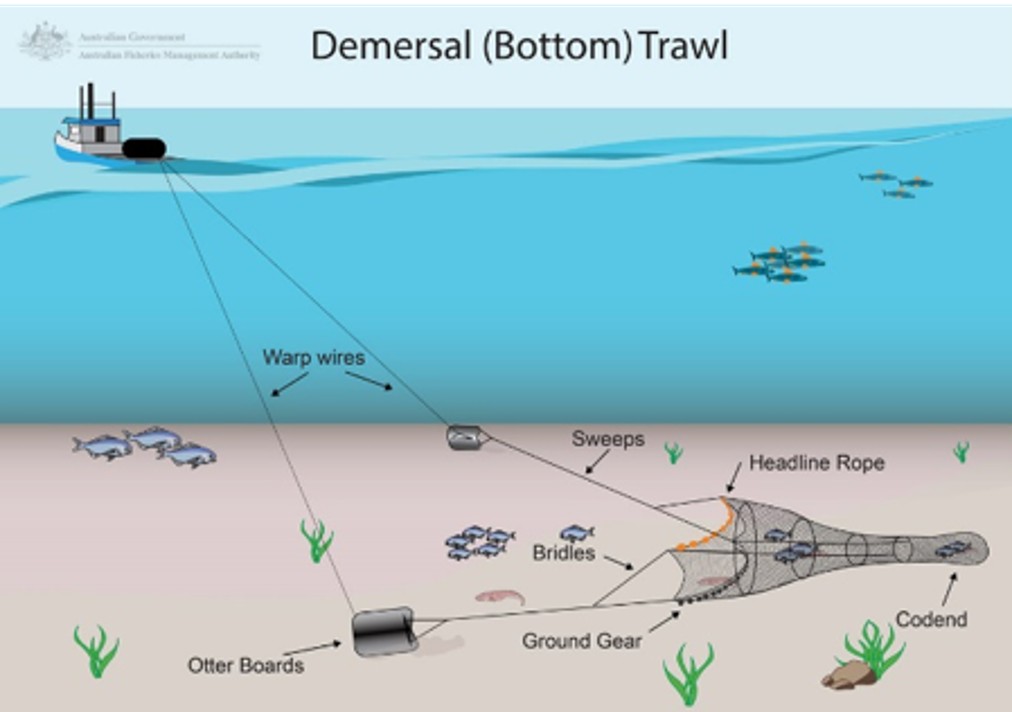 |
| Commercial fishing can actually increase the amount of fish that grow each year by taking out the ______. | top predators (this leaves the smaller faster growing young fish a better chance of survival) |
| Fish that are caught accidently during commercial fishing and are thrown back in the ocean dead are referred to as _____. | bycatch |
| Genetically modified salmon grow faster because they have had a _____ from another fish added to their cells. | gene |
| What can you put near streams and rivers to prevent erosion and help keep the water cooler? | Trees (They also help provide more habitat when they die and fall into the stream because they change the flow of water and help deeper pools of water to form) |
| A big threat to salmon is the building of ____ power plants. | hydroelectric (Hydroelectric power plants use dams to generate electricity, but the dams make it hard for the salmon to migrate back upstream to reproduce) |
| The name of the substance that can be found in high concentrations in large predatory fish like tuna because it biomagnifies is ____. It is especially harmful to babies because it causes problems with brain development. | mercury, 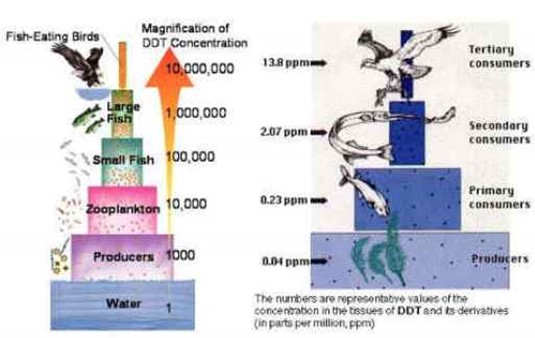 |
| The pesticide that biomagnifies and almost wiped out some top predator birds like the Bald Eagle before its use was banned is ____. | DDT,  |
| The process of ____ can lead to high levels of toxic substances in top-predators even though it might have pretty low concentrations in organisms near the bottom of the food chain. | biomagnification,  |
Suppose this curve represents the population growth curve of a type of fish called Cod. The population grows at different rates depending on what the starting population is. If the current biomass of cod is 30,000 metric tons, what does the graph predict will be the biomass 1 year later?, 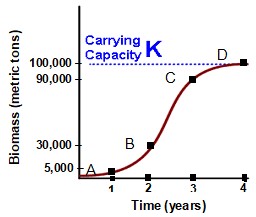 | 90,000 metric tons (Look at the x-axis just below point B where the population along the y-axis is at 30,000 metric tons. Then go to point C. Looking at the x-axis, you can see that 1 year passed by, and by looking at the y-axis across from point C, you can see that the new population is 90,000 metric tons),  |
Suppose this curve represents the population growth curve of a type of fish called Cod. The population grows at different rates depending on what the starting population is. If the current biomass of cod is 5,000 metric tons, what does the graph predict will be the biomass 1 year later?,  | 30,000 metric tons (Look at the x-axis just below point A where the population along the y-axis is at 5,000 metric tons. Then go to point B. Looking at the x-axis, you can see that 1 year passed by, and by looking at the y-axis across from point B, you can see that the new population is 30,000 metric tons),  |
Suppose this curve represents the population growth curve of a type of fish called Cod. The population grows at different rates depending on what the starting population is. Based on this graph, what is the most amount of cod that can be caught sustainably year after year?,  | 60,000 metric tons (If you allow the fishing fleet to fish the population down to 30,000 metric tons, it will recover to 90,000 metric tons by the following year. You can see this happening between points B and C on the graph. However, if you want the fish population to get back to it's carrying capacity every year, you can only take 10,000 metric tons out. You can see this by looking at what happens between points C and D. To strike a balance between nature and business, the National Marine Fisheries service would allow the fish stocks to only recover to 90% of carrying capacity instead of 100%. This allows the fishing fleet to take out 60,000 metric tons year after year instead of only 10,000 metric tons while still keeping the fish population relatively healthy and sustainable. This is a concept called "maximum sustainable yields."),  |
What is the name of the process that is being shown in this picture?,  | biomagnification,  |
What type of commercial fishing is being shown in this picture?,  | pot fishing,  |
What type of commercial fishing is being shown in this picture?, 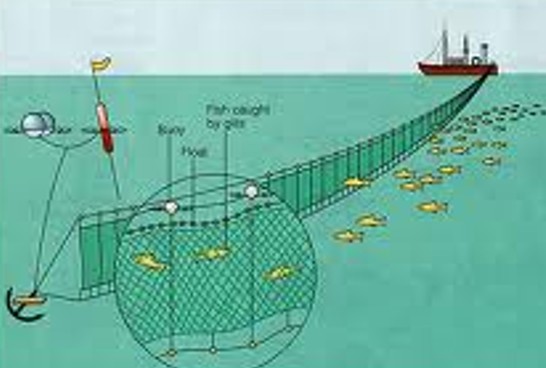 | Drift netting,  |
What type of commercial fishing is being shown in this picture?, 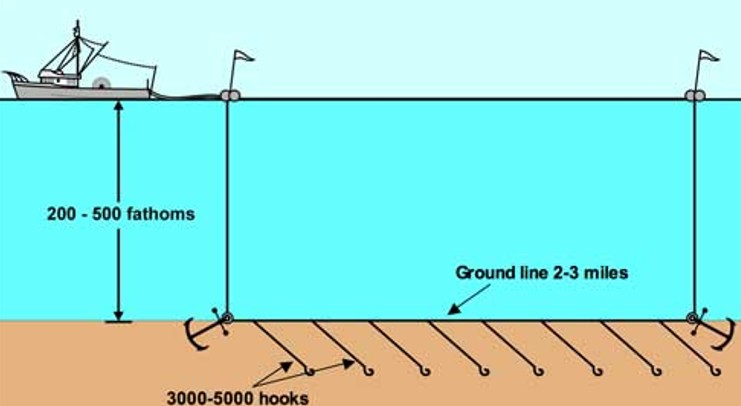 | Longlining,  |
| Which type of commercial fishing does the most damage to habitat at the bottom of the ocean? | Trawling (because they are dragging a large net across the bottom),  |
| Erosion, caused by ____ on steep hillsides leading down to streams where salmon hatch and grow a little before heading out to sea, can make it harder for salmon to survive. | logging |
| _____ fishing is a practice of limiting how much fish is caught each year so that the fish populations can recover by the start of the next fishing season and allow for good fishing year after year. | Sustainable |
| Fisheries biologists use computer models to calculate what the greatest amount of fish that can be caught in a season before the season gets closed is, but still allows the fish to recover by the start of the next season so that commercial fishermen can make a good living for many years to come. This amount of fish is called the _______. | maximum sustainable yield |
| When you hear someone talk about GM fish, what does the GM stand for? | genetically modified |
| The biggest environmental concern when it comes to aquaculture is that the fish might accidently _____. | escape into the wild (This would be bad because there's a possibility that they could spread their genetically modified gene into wild populations, giving them a mating advantage because bigger fish attract more mates, but the GM fish probably have a lot of other genes that aren't as good as the fish in the wild because they are not thinned out by natural selection) |